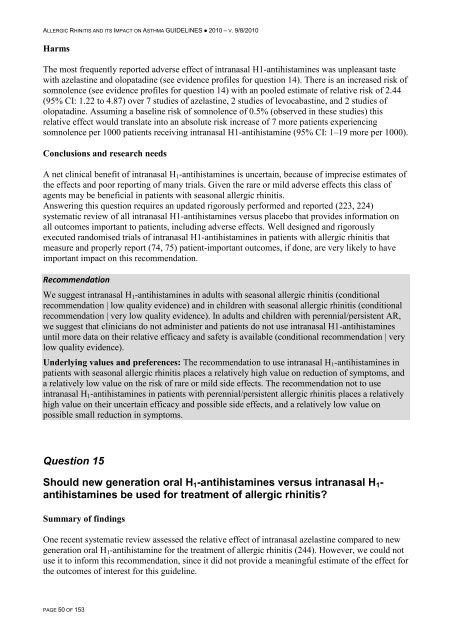Allergic Rhinitis and its Impact on Asthma - ARIA
Allergic Rhinitis and its Impact on Asthma - ARIA
Allergic Rhinitis and its Impact on Asthma - ARIA
Create successful ePaper yourself
Turn your PDF publications into a flip-book with our unique Google optimized e-Paper software.
ALLERGIC RHINITIS AND ITS IMPACT ON ASTHMA GUIDELINES ● 2010 – V. 9/8/2010<br />
Harms<br />
The most frequently reported adverse effect of intranasal H1-antihistamines was unpleasant taste<br />
with azelastine <str<strong>on</strong>g>and</str<strong>on</strong>g> olopatadine (see evidence profiles for questi<strong>on</strong> 14). There is an increased risk of<br />
somnolence (see evidence profiles for questi<strong>on</strong> 14) with an pooled estimate of relative risk of 2.44<br />
(95% CI: 1.22 to 4.87) over 7 studies of azelastine, 2 studies of levocabastine, <str<strong>on</strong>g>and</str<strong>on</strong>g> 2 studies of<br />
olopatadine. Assuming a baseline risk of somnolence of 0.5% (observed in these studies) this<br />
relative effect would translate into an absolute risk increase of 7 more patients experiencing<br />
somnolence per 1000 patients receiving intranasal H1-antihistamine (95% CI: 1–19 more per 1000).<br />
C<strong>on</strong>clusi<strong>on</strong>s <str<strong>on</strong>g>and</str<strong>on</strong>g> research needs<br />
A net clinical benefit of intranasal H1-antihistamines is uncertain, because of imprecise estimates of<br />
the effects <str<strong>on</strong>g>and</str<strong>on</strong>g> poor reporting of many trials. Given the rare or mild adverse effects this class of<br />
agents may be beneficial in patients with seas<strong>on</strong>al allergic rhinitis.<br />
Answering this questi<strong>on</strong> requires an updated rigorously performed <str<strong>on</strong>g>and</str<strong>on</strong>g> reported (223, 224)<br />
systematic review of all intranasal H1-antihistamines versus placebo that provides informati<strong>on</strong> <strong>on</strong><br />
all outcomes important to patients, including adverse effects. Well designed <str<strong>on</strong>g>and</str<strong>on</strong>g> rigorously<br />
executed r<str<strong>on</strong>g>and</str<strong>on</strong>g>omised trials of intranasal H1-antihistamines in patients with allergic rhinitis that<br />
measure <str<strong>on</strong>g>and</str<strong>on</strong>g> properly report (74, 75) patient-important outcomes, if d<strong>on</strong>e, are very likely to have<br />
important impact <strong>on</strong> this recommendati<strong>on</strong>.<br />
Recommendati<strong>on</strong><br />
We suggest intranasal H1-antihistamines in adults with seas<strong>on</strong>al allergic rhinitis (c<strong>on</strong>diti<strong>on</strong>al<br />
recommendati<strong>on</strong> | low quality evidence) <str<strong>on</strong>g>and</str<strong>on</strong>g> in children with seas<strong>on</strong>al allergic rhinitis (c<strong>on</strong>diti<strong>on</strong>al<br />
recommendati<strong>on</strong> | very low quality evidence). In adults <str<strong>on</strong>g>and</str<strong>on</strong>g> children with perennial/persistent AR,<br />
we suggest that clinicians do not administer <str<strong>on</strong>g>and</str<strong>on</strong>g> patients do not use intranasal H1-antihistamines<br />
until more data <strong>on</strong> their relative efficacy <str<strong>on</strong>g>and</str<strong>on</strong>g> safety is available (c<strong>on</strong>diti<strong>on</strong>al recommendati<strong>on</strong> | very<br />
low quality evidence).<br />
Underlying values <str<strong>on</strong>g>and</str<strong>on</strong>g> preferences: The recommendati<strong>on</strong> to use intranasal H1-antihistamines in<br />
patients with seas<strong>on</strong>al allergic rhinitis places a relatively high value <strong>on</strong> reducti<strong>on</strong> of symptoms, <str<strong>on</strong>g>and</str<strong>on</strong>g><br />
a relatively low value <strong>on</strong> the risk of rare or mild side effects. The recommendati<strong>on</strong> not to use<br />
intranasal H1-antihistamines in patients with perennial/persistent allergic rhinitis places a relatively<br />
high value <strong>on</strong> their uncertain efficacy <str<strong>on</strong>g>and</str<strong>on</strong>g> possible side effects, <str<strong>on</strong>g>and</str<strong>on</strong>g> a relatively low value <strong>on</strong><br />
possible small reducti<strong>on</strong> in symptoms.<br />
Questi<strong>on</strong> 15<br />
Should new generati<strong>on</strong> oral H1-antihistamines versus intranasal H1antihistamines<br />
be used for treatment of allergic rhinitis?<br />
Summary of findings<br />
One recent systematic review assessed the relative effect of intranasal azelastine compared to new<br />
generati<strong>on</strong> oral H1-antihistamine for the treatment of allergic rhinitis (244). However, we could not<br />
use it to inform this recommendati<strong>on</strong>, since it did not provide a meaningful estimate of the effect for<br />
the outcomes of interest for this guideline.<br />
PAGE 50 OF 153


